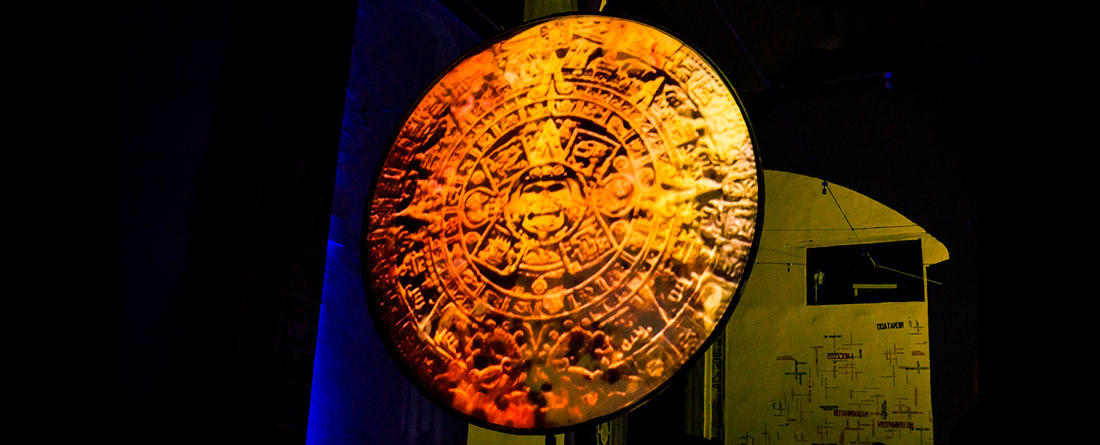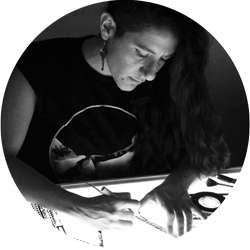
Annalisa Quagliata / México
Proyección – Filux Lab
Patio de la Universidad Autónoma de Yucatán
Calle 60 491, Centro.
Reflejo Solar es una obra que busca reflejar los mitos de los orígenes cósmicos mexicas. La pieza es una video instalación en la que se proyecta en una pantalla circular la imagen de la Piedra del sol y una serie de retratos filmados en el centro histórico. La obra se enfoca en la Leyenda de los soles, representada en la Piedra del sol, y en las ilustraciones de varios símbolos mexicas como el dios del sol Tonatiuh, los puntos cardinales, los 20 días del calendario Tonalpohualli, las serpientes de fuego xiuhcóatls que acompañan al dios en su recorrido celeste, entre otros. Todo el material audiovisual se filmó en película 16mm, el material fílmico con la imagen de la Piedra del sol fue pintado a mano con tintes que van del amarillo al rojo.
El montaje del video entreteje las diferentes superficies en donde se filma el reflejo de la luz del sol; los espacios urbanos y las personas se vuelven la pantalla del reflejo solar. A su vez, la video instalación es un juego de luces: el proyector se dirige hacia un espejo (el mismo que se utilizó para hacer los retratos) y éste refleja la luz hacia la pantalla. Así, la imagen de La piedra del sol y los retratos se vuelven también un reflejo.
Después de la conquista, la Piedra del Sol fue enterrada bajo la instrucción del arzobispo fray Alonso de Montúfar para que "se perdiese la memoria del antiguo sacrificio que allí se hacía". Hoy en día la Piedra del Sol es ícono del patrimonio cultural de México y símbolo de la riqueza cultural prehispánica. Reflejo Solar busca celebrar esta imagen y por medio de la luz revivir su mensaje. Es una reflexión audiovisual sobre la relevancia y la influencia del pasado mesoamericano en el presente.
Reflejo Solar ‘Solar Reflection’ is a work that wants to reflect the Mexica cosmic origins’ myths. The piece is a video installation in which the Sun Stone is projected into a circular screen toghether with a series of pictures taken in the Centro Histórico ‘Historical Downtown’. All the audiovisual material was filmed in a 16mm film, the material with the image of the Sun Stone was hand painted with shades that go from yellow to red.
The video set up interwave the different surfaces in which the sun reflection is filmed: the urban spaces and the people come back to the sun reflection´s screen. At the same time, the video installation is a light play: the projector is directed to a mirror (the same that was used to make the portraits) and it reflects the light to the screen. That way, the image of the solar stone and the portraits become a reflection too.
After the Conquest, the solar stone was buried under the command of Archbishop fray Alfonso de Montúfar so “the memory of the ancient sacrifice that it was performed there, can get lost”. Today the Solar Stone is an icon of the Mexican cultural heritage and a symbol of the richness of Prehispanic culture.
Reflejo Solar wants to celebrate this image and through light, to live its message again. It is an audiovisual reflection about the relevance and influence of the mesoamerican past, on the present.
Reflejo Solar jump’éel meyaj ku kaxtik u chikbesik jejeláas tsikbalo’ob yo’olal bix uchik u yantal mexicas. Jump’éel instalacionil cha’an tu’ux ku chikbesa’al ti’ jump’éel wóolis páantalla u yoochel Piedra del sol, yéetel jayp’éel u yoochelo’ob wíinik jóok’sa’ab k’íiwik. Tuláakal audiovisual ba’al ku ye’esa’ale’ jóok’sa’ab u cha’anil 16 mm, oochel ku cha’anta’al yo’olal Piedra del sol j bo’on yéetel boonilo’ob ku yantal ichil k’an tak chak.
Reflejo Solar ku kaxtik u ki’ óoltik úuchben oochel yáax beeta’ane’ yéetel u jets’ik ba’ax u k’áat u ya’al yéetel sáasil. Jump’éel audiovisual tuukul yo’olal u k’a’ananil yéetel bix u chikpajal u yúuchben k’iinilo’ob Mesoamerica, walkila’.

Annalisa D. Quagliata (n. Veracruz) es una artista visual cuyas películas e instalaciones se enfocan en el cuerpo humano y el retrato. Tiene un gran interés por formatos analógicos y película hecha a mano como medio que captura la poética de la luz y la imagen en movimiento.
Su obra se ha exhibido internacionalmente, incluyendo Museum of the Moving Image y Mono No Aware Festival (Nueva York), Museo Tamayo (México), Bienal de la Imagen en Movimiento (Argentina), VideoEx (Suiza), Filmadrid (España), entre otros.
Annalisa D. Quagliata Born in the state of Veracruz, Mexico is a visual artist whose movies and installations are focused in the picture and the human body. She is much interested in analogical and movie formats as a mean that captures poetic light and moving image. Her work has been showed internationaly including in the Museum of the Moving Image and Mono No Aware Festival (Nueva York), Museo Tamayo (Mexico), Bienal de la Imagen en Movimiento (Argentina), VideoEx (Suitzerland), Filmadrid (Spain), among others.
Annalisa D. Quagliata (síij Veracruz) juntúul x e’esaj its’at beetik cha’ano’ob yéetel instalaciono’ob yo’olal u wíinkilal yéetel u yoochel máak. Jach uts tu yich ba’al analógico yéetel cha’ano’ob beeta’an tu k’ab máak, tu’ux ku ye’esa’al u ik’il t’aanil sáasil yéetel oochel ku péek.
U meyaje’ e’esa’an ti’ táanxel lu’umo’ob je’el bix Museum of the Moving Image yéetel Mono No Aware Festival (Nueva York), Museo Tamayo (México), Bienal de la Imagen en Movimiento (Argentina), VideoEx (Suiza), Filmadrid (España), ichil uláak’o’ob.
